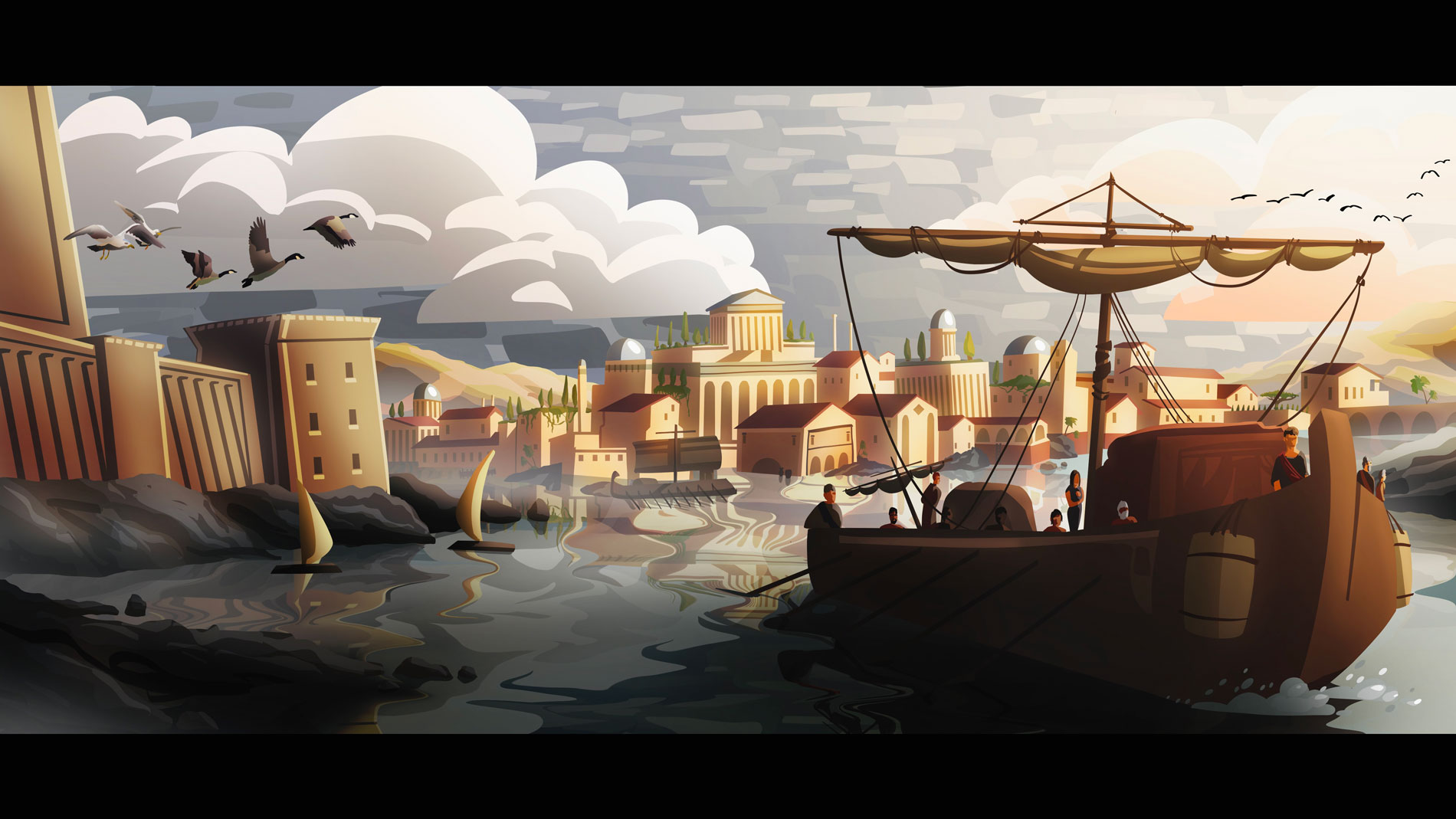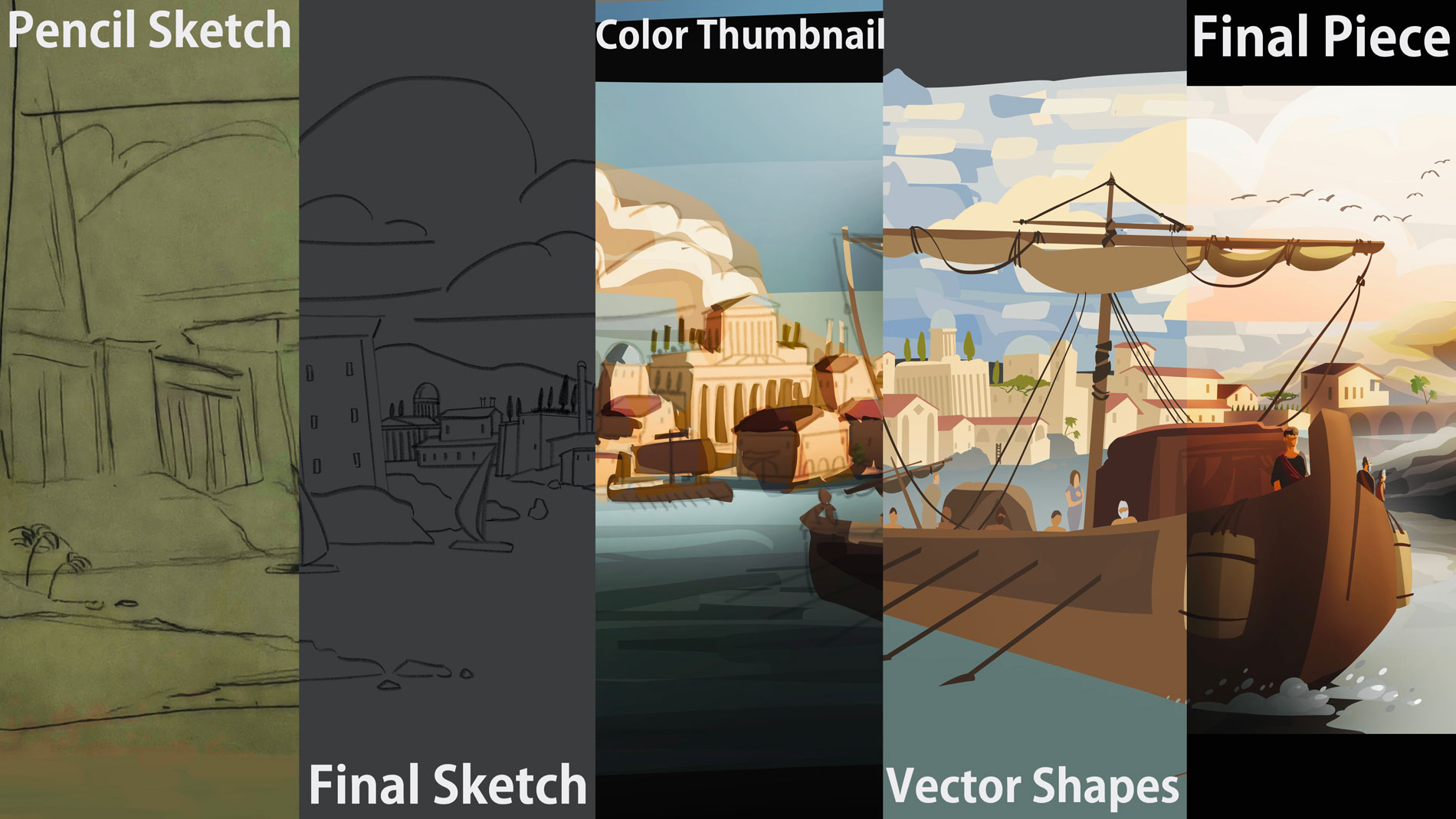


Caesar Departs from Rome
Height: 9" x Width: 16" | Material(s): Adobe Fresco, iPad | Process(es): Compose sketches, plan color/light, block shapes in vectors, render shadows/gradients, cinema border | Idea(s): I worked to create an establishing landscape shot to introduce the setting of my cinematic tale. | Curatorial Note: This is a powerful image that uses dramatic lighting with contrast and good expression of figure-ground relationships to create a sense of space.
Daniel Stordahl
Student statement
Student statement
Please describe the context for how the idea for this artwork originated (was this part of your sustained investigation, an independent project, a class assignment, created during a summer study, etc.).
“Caesar Departs from Rome” is the first piece in my 15-part digital series “Ultionem Si Julius Caesar” (Latin for “The Revenge of Julius Caesar”). Inspired by history, the series tells the story of young Julius Caesar’s capture by pirates in 75 BC and his vow to return and destroy them. These pieces, created in Adobe Fresco, combine my love for cinema and history to explore themes like the danger of unchecked pride. The first piece is a wide, cinematic shot that introduces ancient Rome, setting the stage for Caesar’s journey.
In what ways did you practice and experiment when developing your sustained investigation?
One way I experimented during my sustained investigation was by studying cinematic techniques to tell a story and convey emotion in a single shot. I was constantly learning and pushing myself to try new approaches, whether through composition, cinematic lighting, blocking, texture, or character design. To create new images from scratch, I began with thumbnail sketches, refining each idea while experimenting with different techniques to enhance the storytelling. This process allowed me to explore new creative methods while developing visually compelling and emotionally resonant pieces.

Material(s): Paper, pencil, Adobe Fresco, iPad | Process(es): Compose sketches, plan color/light, block shapes in vectors, render shadows/gradients, cinema border
How did your materials and process(es) choices shape the creation or meaning of your artwork(s)?
I used Adobe Fresco on iPad to create this series, a unique software that combines pixel and vector layers. This allowed me to maintain a consistent art style throughout the series, making the story more cohesive. Being a digital painting software, Fresco enabled me to experiment with different colors and values, helping me emphasize key elements and set the mood for each piece.
How did you demonstrate revision in your sustained investigation?
I began each piece with a pencil sketch, often creating three to five variations before selecting the strongest composition. I then created a refined sketch in Adobe Fresco, adding base colors and defining the forms of each shape. Shadows came next to create depth, followed by texture and overlay layers to add gradients, enhancing the values and colors within the scene.
Your work was selected in part because it achieved synthesis. Can you explain your intentionality in choosing materials and developing processes to further your ideas?
Throughout every step, I was intentional about contributing to the bigger picture of the story. For example, in "Caesar Departs from Rome," I wanted viewers to feel the power and glory of Rome, represented by the sunlit city in the background. At the same time, I positioned Julius Caesar venturing toward a cloud-covered area, symbolizing the danger and uncertainty of the outside world while foreshadowing the peril he would encounter. This deliberate process ensured that each element added meaning and contributed to the narrative.

Combining my passion for cinema and history, I chose this tale to illustrate the danger of unchecked pride.
How did your art teacher support your artistic development?
During my sustained investigation, I practiced revision by seeking feedback from my art teacher throughout the process rather than waiting until the end. For example, in my piece “Caesar Departs from Rome,” I asked for input on the lighting and color scheme of the city in the background. My teacher recommended using warmer tones to reflect sunlight hitting the buildings. Working digitally allowed me to easily revise the colors, and the final version features improved warmth and dynamic values in the background. This process of constant feedback and revision was key to crafting stronger, more polished pieces.
How did your school leadership (principal, assistant principal, guidance counselor, etc.) support your growth as an art student? This could be classroom visits, attending art shows, talking to you about your goals, etc.
During the school year, some of my pieces won awards at a local art show, including “Caesar Departs from Rome." The school displayed my artwork and posted a photo of me holding it, congratulating me for the award. This recognition was encouraging, as teachers I hadn’t spoken to in a while congratulated me, motivating me to put even more effort into my work.
What is your advice to other AP Art and Design students?
My advice to other AP students is to find a story you are truly passionate about, whether it's a personal journey or something from history, like ancient Rome. Use your craft to bring that story to life. Stories have the power to connect, inspire, and change hearts. They can teach, challenge perspectives, and stir emotions in ways nothing else can. Everyone has a story to tell, but it's up to us as artists to turn the ideas in our minds into something the world can see, feel, and understand. Through our art, we have the ability to spark change and make a lasting impact.

Brian Perry
Art Educator
Prior Lake High School, Savage, MN, USA
Teacher statement
Teacher statement
What formative and summative assessments helped guide your students through your AP Art and Design curriculum?
In AP Art and Design, I have my students complete a formative sketchbook assignment along with each of their summative portfolio pieces. As the students develop through their inquiry, the sketchbook provides structure and reflection. Students draw out plans for their next portfolio piece in these sketchbooks, including any technical practice and composition planning they find necessary. During their development process, the students are required to seek and respond to feedback from me and one of their fellow students. At the completion of each portfolio piece, students share their artwork with the class, promoting conversation about process, inspiration and future ideas to encourage revision and experimentation.
What creative programming (i.e., exhibit spaces, mentoring programs, curricular supports) have you implemented to support AP Art and Design students?
To showcase the most recent AP student projects, display walls are set outside the classroom and available for anyone to view. In addition to these display walls, there are display cases in the school cafe for students to show their work. Providing this display place to students gives them an opportunity to showcase their work in a more formal setting. Another way that this course supports students is by bringing in students from previous years to share their experiences and bring insight to the current students about their own projects. Current students are given the opportunity to ask past students questions and gain inspiration for their own portfolios.
What did you learn from working with your student?
During Daniel’s process, he checked in with me regularly for feedback, and each time I learned more about this story and about the development of his illustrations. From his initial sketches and storyboards to the finalized pieces, Daniel showed that he did the background work necessary to make his digital drawings truly spectacular. He practiced his figure drawing from staged photos and live references along with working with lighting and perspective to make his scenes feel lively and expansive. What was so inspiring to me was his ability to document his creative process and convey how these images came to life in his Sustained Investigation.

John Bezek
Principal of Prior Lake High School
Prior Lake High School, Savage, MN, USA
Leader statement
Leader statement
What are you most proud of regarding your school’s AP Art and Design program, student, and teacher?
Prior Lake High School prides itself on developing well-rounded learners. The Art Department has a long history of working with all learners to excel, and our AP Art class allows us to have a capstone experience for those who rise to the challenge. We take great joy in seeing a student such as Daniel Stordahl find his passion and achieve such an elite level under the tutelage of our instructor Brian Perry.
What do you do to support visual arts programming in your school?
We make sure that the arts are celebrated at Prior Lake High School. We belong to the Suburban East Conference that hosts a long-standing Fine Arts Festival where all modes of artistic expression are recognized and celebrated. In addition, we support a wide variety of art courses, and our facilities are excellent.
What is your advice to other school leaders on how to support an AP Art and Design program?
We owe it to our students to provide a well-rounded education and to celebrate the arts. Find your champions and let them run with their ideas, and they will produce outstanding results.

Daniel Stordahl





